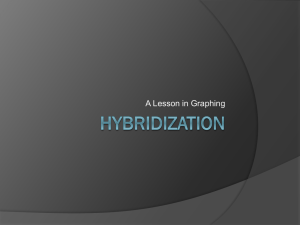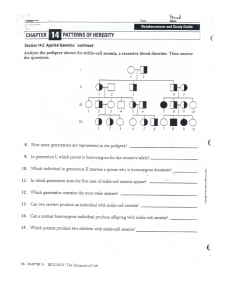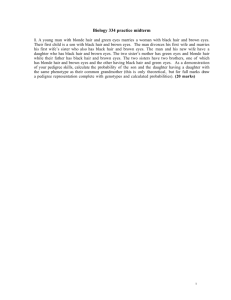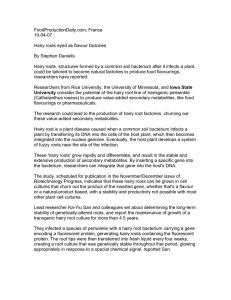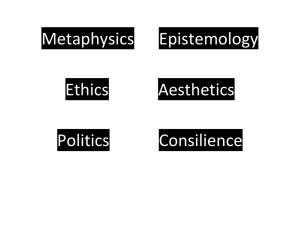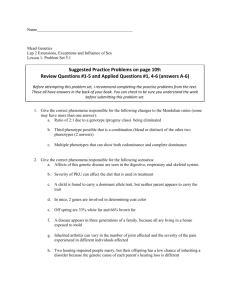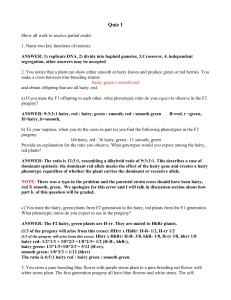reading Wild Plants
advertisement
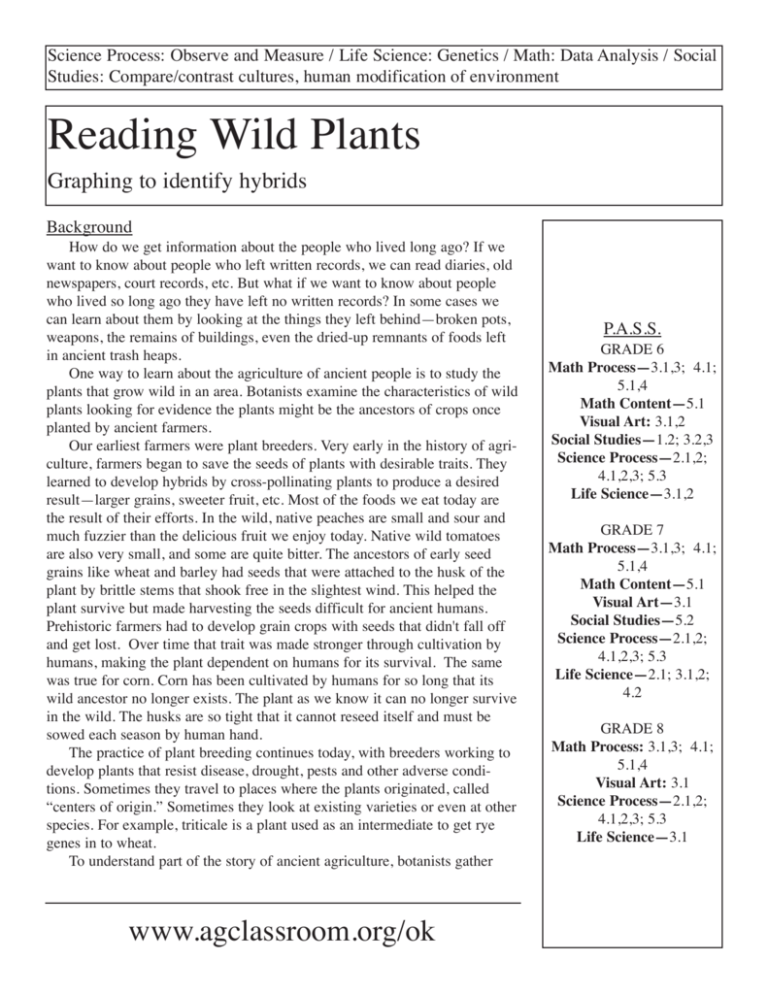
Science Process: Observe and Measure / Life Science: Genetics / Math: data Analysis / Social Studies: Compare/contrast cultures, human modification of environment reading Wild Plants Graphing to identify hybrids Background How do we get information about the people who lived long ago? If we want to know about people who left written records, we can read diaries, old newspapers, court records, etc. But what if we want to know about people who lived so long ago they have left no written records? In some cases we can learn about them by looking at the things they left behind—broken pots, weapons, the remains of buildings, even the dried-up remnants of foods left in ancient trash heaps. One way to learn about the agriculture of ancient people is to study the plants that grow wild in an area. Botanists examine the characteristics of wild plants looking for evidence the plants might be the ancestors of crops once planted by ancient farmers. Our earliest farmers were plant breeders. Very early in the history of agriculture, farmers began to save the seeds of plants with desirable traits. They learned to develop hybrids by cross-pollinating plants to produce a desired result—larger grains, sweeter fruit, etc. Most of the foods we eat today are the result of their efforts. In the wild, native peaches are small and sour and much fuzzier than the delicious fruit we enjoy today. Native wild tomatoes are also very small, and some are quite bitter. The ancestors of early seed grains like wheat and barley had seeds that were attached to the husk of the plant by brittle stems that shook free in the slightest wind. This helped the plant survive but made harvesting the seeds difficult for ancient humans. Prehistoric farmers had to develop grain crops with seeds that didn't fall off and get lost. Over time that trait was made stronger through cultivation by humans, making the plant dependent on humans for its survival. The same was true for corn. Corn has been cultivated by humans for so long that its wild ancestor no longer exists. The plant as we know it can no longer survive in the wild. The husks are so tight that it cannot reseed itself and must be sowed each season by human hand. The practice of plant breeding continues today, with breeders working to develop plants that resist disease, drought, pests and other adverse conditions. Sometimes they travel to places where the plants originated, called “centers of origin.” Sometimes they look at existing varieties or even at other species. For example, triticale is a plant used as an intermediate to get rye genes in to wheat. To understand part of the story of ancient agriculture, botanists gather www.agclassroom.org/ok P.A.S.S. GrAde 6 Math Process—3.1,3; 4.1; 5.1,4 Math Content—5.1 Visual Art: 3.1,2 Social Studies—1.2; 3.2,3 Science Process—2.1,2; 4.1,2,3; 5.3 Life Science—3.1,2 GrAde 7 Math Process—3.1,3; 4.1; 5.1,4 Math Content—5.1 Visual Art—3.1 Social Studies—5.2 Science Process—2.1,2; 4.1,2,3; 5.3 Life Science—2.1; 3.1,2; 4.2 GrAde 8 Math Process: 3.1,3; 4.1; 5.1,4 Visual Art: 3.1 Science Process—2.1,2; 4.1,2,3; 5.3 Life Science—3.1 samples of wild plants to examine their traits. They organize the information they gather to find out if some of the plants might have descended from plants that were once crops grown by ancient farmers. Since they are examining several traits—stem height, leaf width, color, etc.—they need methods that help them keep track of all the information. Graphing is one method scientists use to help them organize the information. Legend for Activity Three Hairy red No Hair White Activities ACTIVITy ONe (POWer POINT SLIdeS 1-8): WHAT IS A HyBrId? 1. Students will discuss the meaning of the word “hybrid.” 2. Students will discuss some real life examples of plant and animal hybrids. ACTIVITy TWO (POWer POINT SLIde 9) 1. Student will each: —Place a clean sheet of paper in front of them in the landscape (horizontal) position. —Fold the left edge into the center and crease. —Fold the right edge into the center and crease. This will create two flaps. —draw a different animal, fruit, vegetable or flower on the outside of each flap. The plants may be real or make believe. —Open the flaps, and, in the center, draw what they think the hybrid of the two outside plants or animals would look like. ACTIVITy THree (POWer POINT SLIdeS 10-13) 1. Students will each create a chart to record the data from the Plant Card Set included with this lesson. —Students will collect data in four categories: plant height, petal length, petal color and stem (no hair, sligthly hairy or very hairy) 2. distribute Plant Card Set. —Students will collect and record the data on the charts they have created. —Students will measure plant height and petal height using centimeters. 3. When all data is collected students will create a coordinate plot, using the plant height as the x-axis and petal length as y-axis. 4. Students will then add the data for hairiness and petal color, using the symbols at left to represent the different characteristics. 5. After students have completed graphing the data, discuss the following questions: —How many different species are represented on the graph? —Are any hybrids present? How do you know? ACTIVITy FOur (POWer POINT SLIde 12-13) 1. Give students the Plant data Table included with this lesson. 2. Students will graph all data on a coordinate graph: plant height on the x-axis, petal length on the y-axis. The legend for the other two cate- www.agclassroom.org/ok gories of data (stem hair, petal color) are at right. 3. After students have completed their graphs, discuss the following questions: —How many different species are represented in the graph? —Are any hybrids present? How do you know? Legend for Activity Four extra reading Burnie, david, Plant, eyewitness Books, dK, 2011.edom, Helen, Science With Plants, usborne, 2007. edom, Helen, Science With Plants, usborne, 2007. Hesser, Leon, The Man Who Fed the World: Nobel Prize Laureate Norman Borlaug and His Battle to End World Hunger, durban House, 2006. Juettner, Bonnie, The Seed Vault , Norwood House, 2009. Simpson, Kathleen, Genetics: From DNA to Designer Dogs, National Geographic, 2008. Woods, Michael, and Mary B. Woods, Ancient Agricultural Technology: From Sickles to Plows (Technology in Ancient Cultures, 21st Century, 2011. Very Hairy Slightly Hairy White red No Hair Pink Vocabulary agriculture—the science or occupation of cultivating the soil, producing crops, and raising livestock botanist—someone who studies plant life (as of a given region) characteristic—a special quality or appearance that makes an individual or group different from others cultivate—to raise or assist the growth of by tilling or by labor and care dependent—relying on another for support harvest—the gathering of a crop husk—a usually thin dry outer covering of various seeds or fruits hybrid—an offspring of parents with different genes especially when of different races, breeds, species, or genera native—living or growing naturally in a particular region population—a group of one or more species of organisms living in a particular area or habitat prehistoric—of, relating to, or existing in times before written history sow—to plant seed for growth especially by scattering trait—an inherited characteristic variation—change in the characteristics that are usual for a species or group wild—growing or produced without human aid and care www.agclassroom.org/ok Name _______________________________ Plant Card Set (Activity Three) Oklahoma Ag in the Classroom is a program of the Oklahoma Cooperative extension Service, the Oklahoma department of Agriculture, Food and Forestry and the Oklahoma State department of education. Name _________________________ Plant data Table (Activity 4) Plant Height Petal Length Stem Petal Color 6 cm 2 cm No Hair White 4 cm 1.5 cm No Hair White 9 cm 2.5 cm Slightly Hairy Pink 13 cm 4 cm Slightly Hairy red 8 cm 2.5 cm Slightly Hairy White 15 cm 4.5 cm Very Hairy red 11 cm 3 cm Slightly Hairy Pink 12 cm 3.5 cm Very Hairy Pink 7 cm 2 cm No Hair White 17 cm 4.5 cm Vey Hairy red 14.5 cm 4 cm Very Hairy red 4.5 cm 1.5 cm No Hair White 18 cm 5 cm Very Hairy red 10.5 cm 3 cm Slightly Hairy Pink Oklahoma Ag in the Classroom is a program of the Oklahoma Cooperative extension Service, the Oklahoma department of Agriculture, Food and Forestry and the Oklahoma State department of education.
